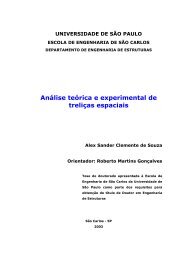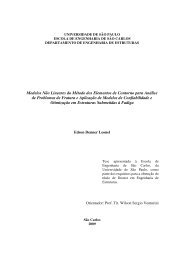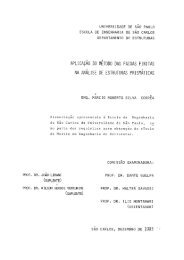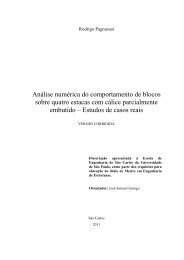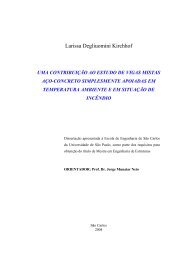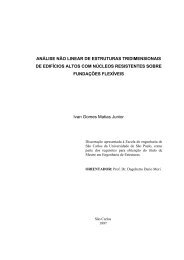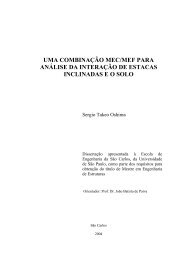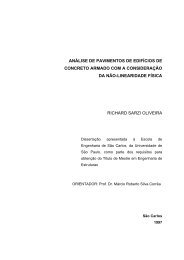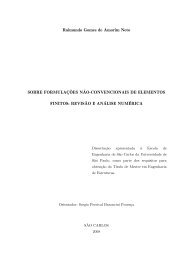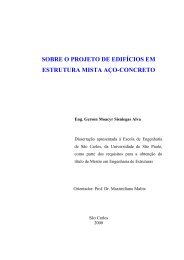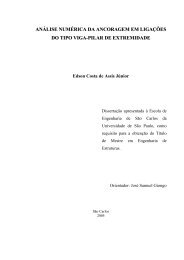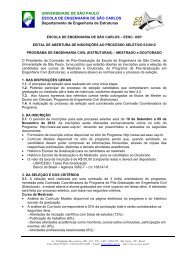o método dos elementos de contorno aplicado à ... - Sistemas SET
o método dos elementos de contorno aplicado à ... - Sistemas SET
o método dos elementos de contorno aplicado à ... - Sistemas SET
Create successful ePaper yourself
Turn your PDF publications into a flip-book with our unique Google optimized e-Paper software.
∂ wq<br />
∂x ∂x<br />
( ) ∂ wq ( )<br />
2 2<br />
=<br />
∂x ∂x<br />
⎛<br />
⎜<br />
⎝<br />
i j i j<br />
⎞<br />
⎟<br />
⎠<br />
e<br />
∫<br />
* 0 0<br />
− e, ( q, p) M ( p) dΩ( p) −g<br />
( q) M ( q)<br />
Ω<br />
ijkl kl ijkl kl<br />
92<br />
(5.36)<br />
A força cortante Qβ, em relação a uma direção xβ (β = 1, 2), é calculada a partir da<br />
equação (5.8), on<strong>de</strong> o valor <strong>de</strong> w, kkβ<br />
, é calculado <strong>de</strong>rivando-se a equação (5.12) do<br />
<strong>de</strong>slocamento w(q) <strong>de</strong> um ponto interno:<br />
( ) ⎞ ⎡ ∂ ⎛ ∂ wq ( )<br />
2 2<br />
∂ ⎛ ∂ wq<br />
⎜ ⎟<br />
∂xβ(<br />
q)<br />
⎜ ∂x ∂x<br />
⎟<br />
⎝ ⎠ ∂xβ(<br />
q)<br />
∂x ∂x<br />
= ⎢ ⎜<br />
⎣⎢<br />
⎝<br />
k k k k<br />
( )<br />
⎡<br />
2<br />
∂ ⎛ ∂ wq⎞<br />
⎤<br />
on<strong>de</strong> ⎢ ⎜<br />
∂xβ(<br />
q)<br />
⎜<br />
⎟<br />
⎝ ∂xk∂x ⎟ ⎥<br />
⎣⎢<br />
k⎠⎦⎥<br />
por (4.60).<br />
e<br />
−<br />
∂<br />
∂x<br />
( q)<br />
β<br />
∫<br />
Ω<br />
e<br />
⎞ ⎤<br />
⎟<br />
⎥<br />
⎠ ⎦⎥<br />
+<br />
2 * ⎛ ∂ w, ⎞<br />
kl ( q, p)<br />
0<br />
⎜<br />
M p ⎟ kl ( ) dΩ( p)<br />
, (5.37)<br />
⎝ ∂x ∂x<br />
⎠<br />
m m<br />
representa a solução sem consi<strong>de</strong>rar momentos iniciais, dada<br />
0<br />
Denominando-se o segundo termo da equação (5.37), <strong>de</strong> Ι ,β , tem-se:<br />
0<br />
Ι ,β =<br />
∂<br />
∂x<br />
( q)<br />
β<br />
∫<br />
Ω<br />
2 * ⎛ ∂ w, ⎞<br />
kl ( q, p)<br />
0<br />
⎜<br />
M p ⎟ kl ( ) dΩ( p)<br />
⎝ ∂x ∂x<br />
⎠<br />
m m<br />
Porém, consi<strong>de</strong>rando-se a equação (5.33), obtém-se:<br />
*<br />
*<br />
∫ ( M ( p) w, ( q, p) ) d ( p)<br />
∫ ( kl klmm )<br />
0 0<br />
Ι = Ω =<br />
, mm kl klmm<br />
Ω<br />
0 *<br />
( ) ( 4δ<br />
kl ) = ∫ ( kl klmm )<br />
+ M q<br />
kl<br />
1<br />
8D<br />
Ω<br />
Ω<br />
0<br />
M ( p) w, ( q, p) dΩ( p)<br />
+<br />
0<br />
M ( p) w, ( q, p) dΩ( p)<br />
+<br />
(5.38)<br />
1 0 0<br />
+ ( M11 + M 22 )<br />
(5.39)<br />
2D<br />
Desse modo, substituindo-se a equação (5.39) em (5.38), po<strong>de</strong>-se escrever:



